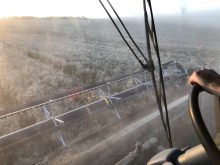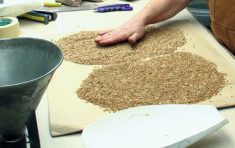Come Aug. 1, Western Canada will get a new ninth milling wheat class, Canada Northern Hard Red (CNHR), that’s expected to open up opportunities for higher-yielding wheats, while preserving the quality reputation of the Canada Western Red Spring (CWRS) and Canada Prairie Spring Red (CPSR) classes.
U.S. Dark Northern Spring varieties Faller, Prosper and Elgin ND, now in the Canada Western Interim Wheat class, will move to the new CNHR class and the interim class will end, the Canadian Grain Commission (CGC) said Friday in a release.
Read Also

India slaps 30 per cent import duty on yellow peas
India has imposed a 30 per cent duty on yellow pea imports with a bill of lading date on or after Nov. 1, 2025.
On Aug. 1, 2018, 25 CWRS and four CPSR wheats will move to the CNHR class. Among the CWRS wheats there are some popular varieties, including Harvest and Kane. The CGC had initially planned to move them in 2017, but are delaying it a year to give the industry more time to adjust.
“We want to make it clear that these varieties are not being deregistered, they’re just moving from one class to another,” Daryl Beswitherick, the CGC’s program manager for quality assurance standards, said in an interview.
“Farmers will just need to know what class the wheats are in by 2018. They will still be legal to grow.”
This Aug. 1 the CGC is also eliminating the Canada Western General Purpose (CWGP) and Canada Feed Wheat classes, transferring the varieties from both to the new Canada Western Special Purpose class. Like the CWGP class, the special purpose class does not require end-use quality be assessed as a prerequisite to registration.
The CWGP class was created in 2008 for wheats suited for ethanol production and livestock feed. But it’s also become home for some higher yielding varieties that don’t meet the milling and end-use requirements of other wheat classes.
Marketability also played a role in the switch to the new special purpose class, Beswitherick said. “General purpose” doesn’t sound as appealing as “special purpose.”
Elwin Hermanson, the CGC’s chief commissioner, announced the wheat class review at the Manitoba Seed Growers’ Association annual meeting in December 2014. He explained the goal was to protect and enhance the CWRS and CPSR classes following several years of complaints from some customers about weaker than normal wheat gluten strength.
An investigation concluded that some new CWRS wheats with gluten strength close to the minimum allowed were among the most popular with farmers. In addition poor weather had resulted in even lower gluten strength. The industry has since agreed to tighter gluten strength standards for the CWRS and CPSR classes.
Over the past 12 months Western Canada’s grain industry has been consulted and there is a consensus to make the changes, Beswitherick said.
The new CNHR class opens the door to new varieties with slightly lower protein and gluten strength and higher yields, while protecting the CWRS class.
“The market will determine what farmers grow,” Beswitherick said, alluding to the possibility that some CNHR wheats will earn less per bushel than CWRS varieties but make as much or more because of higher yields.
For example, in 2015 based on crop insurance yields province-wide Prosper, the highest yielding variety that will be in the new CNHR class, averaged 11 bushels an acre or 19 per cent, more than AAC Elie, the highest-yielding CWRS wheat.
More new varieties could be added to the CNHR class as early as this year. In anticipation of of the new class the Prairie Recommending Committee for Wheat, Rye and Triticale, set up registration trials last year.
Western Canada’s current eight milling wheat classes are as follows: CWRS, CPSR, CPS White, Canada Western Extra Strong, Canada Western Amber Durum, Canada Western Red Winter, Canada Western Soft White and Canada Western Hard White Spring.
The following varieties will be moved from the CWRS and CPSR classes to the CNHR class Aug. 1, 2018.
CWRS: AC Abbey, AC Cora, AC Eatonia, AC Majestic, AC Michael, AC Minto, Alvena, Alikat, CDC Makwa, CDC Osler, Columbus, Conway, Harvest, Kane, Katepwa, Leader, Lillian, McKenzie, Neepawa, Park, Pasqua, Pembina, Thatcher, Unity, 5603HR.
CPSR: AC Formost, AC Taber, Conquer, Oslo.
— Allan Dawson is a reporter for the Manitoba Co-operator at Miami, Man. Follow him at @allanreporter on Twitter.













